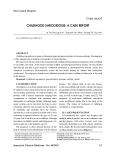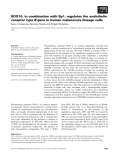
Skin disorder
-
Childhood sarcoidosis is a rare multisystemic granulomatous disorder of unknown etiology. The diagnosis is often delayed due to lacking of recognition of clinical features. We report a 23 month-old boy who presented with multiple pinkish papules and painless cystic swellings in his ankles and wrists. A skin biopsy showed multiple sarcoidal granulomatous lesions.
 5p
5p  vinatisu
vinatisu
 29-08-2024
29-08-2024
 6
6
 0
0
 Download
Download
-
Waardenburg syndrome (WS) is an auditory–pigmentary disorder that exhibits varying combinations of sensorineural hearing loss and abnormal pigmentation of the hair and skin. WS type 4 (WS4), a subtype of WS, is characterized by the presence of the aganglionic megacolon and is associ-
 16p
16p  inspiron33
inspiron33
 26-03-2013
26-03-2013
 32
32
 5
5
 Download
Download
-
Abstract Intercellular signaling by cytokines is a vital feature of the innate immune system. In skin, an inflammatory response is mediated by cytokines and an entwined network of cellular communication between T-cells and epidermal keratinocytes. Dysregulated cytokine production, orchestrated by activated T-cells homing to the skin, is believed to be the main cause of psoriasis, a common inflammatory skin disorder.
 19p
19p  toshiba23
toshiba23
 18-11-2011
18-11-2011
 52
52
 2
2
 Download
Download
-
Harrison's Internal Medicine Chapter 135. Gas Gangrene and Other Clostridial Infections Definition Bacteria of the genus Clostridium are gram-positive, spore-forming, obligate anaerobes that are ubiquitous in nature. There are 60 recognized species of clostridia, many of which are generally considered saprophytic. Some of these species are pathogenic for humans and animals, particularly under conditions of lowered oxidation-reduction potential. Infections associated with these organisms range from localized wound contamination to overwhelming systemic disease.
 5p
5p  colgate_colgate
colgate_colgate
 21-12-2010
21-12-2010
 79
79
 4
4
 Download
Download
-
Table 76-1 Common Characteristics of Anorexia Nervosa and Bulimia Nervosa Anorexia Nervosaa Bulimia Nervosa Clinical Characteristics Onset Mid-adolescence Late adolescence/early adulthood Female:male 10:1 10:1 Lifetime prevalence 1% 1–3% in women Weight Markedly decreased Usually normal Menstruation Absent Usually normal Binge eating 25–50% Required diagnosis for Mortality 5% per decade Low Physical and Laboratory Findingsa Skin/extremities Lanugo Acrocyanosis Edema Cardiovascular Bradycardia Hypotension Gastrointestinal Salivary enlargement gland S...
 5p
5p  konheokonmummim
konheokonmummim
 03-12-2010
03-12-2010
 70
70
 4
4
 Download
Download
-
Neutrophil Abnormalities A defect in the neutrophil life cycle can lead to dysfunction and compromised host defenses. Inflammation is often depressed, and the clinical result is often recurrent with severe bacterial and fungal infections. Aphthous ulcers of mucous membranes (gray ulcers without pus) and gingivitis and periodontal disease suggest a phagocytic cell disorder. Patients with congenital phagocyte defects can have infections within the first few days of life. Skin, ear, upper and lower respiratory tract, and bone infections are common. Sepsis and meningitis are rare.
 6p
6p  konheokonmummim
konheokonmummim
 03-12-2010
03-12-2010
 78
78
 5
5
 Download
Download
-
Pemphigus Vulgaris Pemphigus refers to a group of autoantibody-mediated intraepidermal blistering diseases characterized by loss of cohesion between epidermal cells (a process termed acantholysis). Manual pressure to the skin of these patients may elicit the separation of the epidermis (Nikolsky's sign). This finding, while characteristic of pemphigus, is not specific to this group of disorders and is also seen in toxic epidermal necrolysis, Stevens-Johnson syndrome, and a few other skin diseases.
 5p
5p  konheokonmummim
konheokonmummim
 03-12-2010
03-12-2010
 88
88
 5
5
 Download
Download
-
Pemphigus Foliaceus Pemphigus foliaceus (PF) is distinguished from PV by several features. In PF, acantholytic blisters are located high within the epidermis, usually just beneath the stratum corneum. Hence PF is a more superficial blistering disease than PV. The distribution of lesions in the two disorders is much the same, except that in PF mucous membranes are almost always spared. Patients with PF rarely demonstrate intact blisters but rather exhibit shallow erosions associated with erythema, scale, and crust formation.
 4p
4p  konheokonmummim
konheokonmummim
 03-12-2010
03-12-2010
 81
81
 5
5
 Download
Download
-
Harrison's Internal Medicine Chapter 55. Immunologically Mediated Skin Diseases Immunologically Mediated Skin Diseases: Introduction A number of immunologically mediated skin diseases and immunologically mediated systemic disorders with cutaneous manifestations are now recognized as distinct entities with consistent clinical, histologic, and immunopathologic findings. Many of these disorders are due to autoimmune mechanisms.
 6p
6p  konheokonmummim
konheokonmummim
 03-12-2010
03-12-2010
 86
86
 6
6
 Download
Download
-
Also associated with systemic diseases. b Reviewed in section on Purpura. cReviewed in section on Papulonodular Skin Lesions. d Favors plantar surface of the foot. Note: TEN, toxic epidermal necrolysis. Livedoid vasculopathy (livedoid vasculitis; atrophie blanche) represents a combination of a vasculopathy plus intravascular thrombosis. Purpuric lesions and livedo reticularis are found in association with painful ulcerations of the lower extremities. These ulcers are often slow to heal, but when they do, irregularly shaped white scars are formed.
 5p
5p  konheokonmummim
konheokonmummim
 30-11-2010
30-11-2010
 83
83
 6
6
 Download
Download
-
Palpable purpura are further subdivided into vasculitic and embolic. In the group of vasculitic disorders, cutaneous small-vessel vasculitis, also known as leukocytoclastic vasculitis (LCV), is the one most commonly associated with palpable purpura (Chap. 319). Underlying etiologies include drugs (e.g., antibiotics), infections (e.g., hepatitis C virus), and autoimmune connective tissue diseases. Henoch-Schönlein purpura is a subtype of acute LCV that is seen primarily in children and adolescents following an upper respiratory infection.
 6p
6p  konheokonmummim
konheokonmummim
 30-11-2010
30-11-2010
 85
85
 5
5
 Download
Download
-
Systemic causes of nonpalpable purpura fall into several categories, and those secondary to clotting disturbances and vascular fragility will be discussed first. The former group includes thrombocytopenia (Chap. 109), abnormal platelet function as is seen in uremia, and clotting factor defects. The initial site of presentation for thrombocytopenia-induced petechiae is the distal lower extremity.
 5p
5p  konheokonmummim
konheokonmummim
 30-11-2010
30-11-2010
 82
82
 5
5
 Download
Download
-
Several metabolic disorders are associated with blister formation, including diabetes mellitus, renal failure, and porphyria. Local hypoxia secondary to decreased cutaneous blood flow can also produce blisters, which explains the presence of bullae over pressure points in comatose patients (coma bullae). In diabetes mellitus, tense bullae with clear viscous fluid arise on normal skin. The lesions can be as large as 6 cm in diameter and are located on the distal extremities. There are several types of porphyria, but the most common form with cutaneous findings is PCT.
 5p
5p  konheokonmummim
konheokonmummim
 30-11-2010
30-11-2010
 84
84
 6
6
 Download
Download
-
Table 54-14 Causes of Urticaria and Angioedema I. Primary cutaneous disorders A. Acute and chronic urticariaa B. Physical urticaria 1. Dermatographism 2. Solar urticariab 3. Cold urticariab 4. Cholinergic urticariab C. Angioedema (hereditary and acquired)b II. Systemic diseases A. Urticarial vasculitis B. Hepatitis B or C infection C. Serum sickness D. Angioedema (hereditary and acquired) a A small minority develop anaphylaxis. b Also systemic. The common physical urticarias include dermographism, solar urticaria, cold urticaria, and cholinergic urticaria.
 5p
5p  konheokonmummim
konheokonmummim
 30-11-2010
30-11-2010
 72
72
 6
6
 Download
Download
-
Papulonodular Skin Lesions (Table 54-15) In the papulonodular diseases, the lesions are elevated above the surface of the skin and may coalesce to form plaques. The location, consistency, and color of the lesions are the keys to their diagnosis; this section is organized on the basis of color. Table 54-15 Papulonodular Skin Lesions According to Color Groups I. White A. Calcinosis cutis II. Skin-colored A. Rheumatoid nodules B. Neurofibromas (von Recklinghausen's disease) C. Angiofibromas (tuberous sclerosis, MEN syndrome, type 1) D. Neuromas (MEN syndrome, type 2b) E.
 7p
7p  konheokonmummim
konheokonmummim
 30-11-2010
30-11-2010
 89
89
 6
6
 Download
Download
-
Absence of melanocytes. b Normal number of melanocytes. c Platelet storage defect and restrictive lung disease secondary to deposits of ceroid-like material; one form due to mutations in β subunit of adaptor protein. d Giant lysosomal granules and recurrent infections. The differential diagnosis of localized hypomelanosis includes the following primary cutaneous disorders: idiopathic guttate hypomelanosis, postinflammatory hypopigmentation, tinea (pityriasis) versicolor, vitiligo, chemical leukoderma, nevus depigmentosus (see below), and piebaldism (Table 54-9).
 10p
10p  konheokonmummim
konheokonmummim
 30-11-2010
30-11-2010
 100
100
 5
5
 Download
Download
-
Most patients with trichotillomania, pressure-induced alopecia. The most common causes of nonscarring alopecia include telogen effluvium, androgenetic alopecia, alopecia areata, tinea capitis, and some cases of traumatic alopecia (Table 54-5). In women with androgenetic alopecia, an elevation in circulating levels of androgens may be seen as a result of ovarian or adrenal gland dysfunction. When there are signs of virilization, such as a deepened voice and enlarged clitoris, the possibility of an ovarian or adrenal gland tumor should be considered.
 5p
5p  konheokonmummim
konheokonmummim
 30-11-2010
30-11-2010
 60
60
 4
4
 Download
Download
-
Harrison's Internal Medicine Chapter 54. Skin Manifestations of Internal Disease Skin Manifestations of Internal Disease: Introduction It is now a generally accepted concept in medicine that the skin can show signs of internal disease. Therefore, in textbooks of medicine one finds a chapter describing in detail the major systemic disorders that can be identified by cutaneous signs. The underlying assumption of such a chapter is that the clinician has been able to identify the disorder in the patient and needs only to read about it in the textbook.
 6p
6p  konheokonmummim
konheokonmummim
 30-11-2010
30-11-2010
 94
94
 9
9
 Download
Download
-
Acne Rosacea Acne rosacea, commonly referred to as rosacea, is an inflammatory disorder predominantly affecting the central face. Those most often affected are Caucasians of northern European background, but it is seen in patients with dark skin also.
 5p
5p  konheokonmummim
konheokonmummim
 30-11-2010
30-11-2010
 95
95
 5
5
 Download
Download
-
Lichen Planus Lichen planus (LP) is a papulosquamous disorder that may affect the skin, scalp, nails, and mucous membranes. The primary cutaneous lesions are pruritic, polygonal, flat-topped, violaceous papules. Close examination of the surface of these papules often reveals a network of gray lines (Wickham's striae). The skin lesions may occur anywhere but have a predilection for the wrists, shins, lower back, and genitalia (Fig. 53-5).
 5p
5p  konheokonmummim
konheokonmummim
 30-11-2010
30-11-2010
 94
94
 5
5
 Download
Download
CHỦ ĐỀ BẠN MUỐN TÌM
































